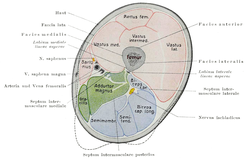Thighs
| Thigh | |
|---|---|

Cross-section of the thigh showing muscles and bone (latin terminology).
|
|
| Details | |
| Identifiers | |
| Latin | femur |
| TA | A01.1.00.035 |
| FMA | 24967 |
|
Anatomical terminology
[]
|
|
In humans, the thigh is the area between the pelvis and the knee. Anatomically, it is part of the lower limb.
The single bone in the thigh is called the femur. This bone is very thick and strong (due to the high proportion of cortical bone), and forms a ball and socket joint at the hip, and a modified hinge joint at the knee.
The femur is the only bone in the thigh and serves for an attachment site for all muscles in the thigh. The head of the femur articulates with the acetabulum in the pelvic bone forming the hip joint, while the distal part of the femur articulates with the tibia and kneecap forming the knee joint. By most measures the femur is the strongest bone in the body. The femur is also the longest bone in the body.
The femur is categorised as a long bone and comprises a diaphysis, the shaft (or body) and two or extremities that articulate with adjacent bones in the hip and knee.
In cross-section, the thigh is divided up into three separate compartments, divided by fascia, each containing muscles. These compartments use the femur as an axis, and are separated by tough connective tissue membranes (or septa). Each of these compartments has its own blood and nerve supply, and contains a different group of muscles.
...
Wikipedia
